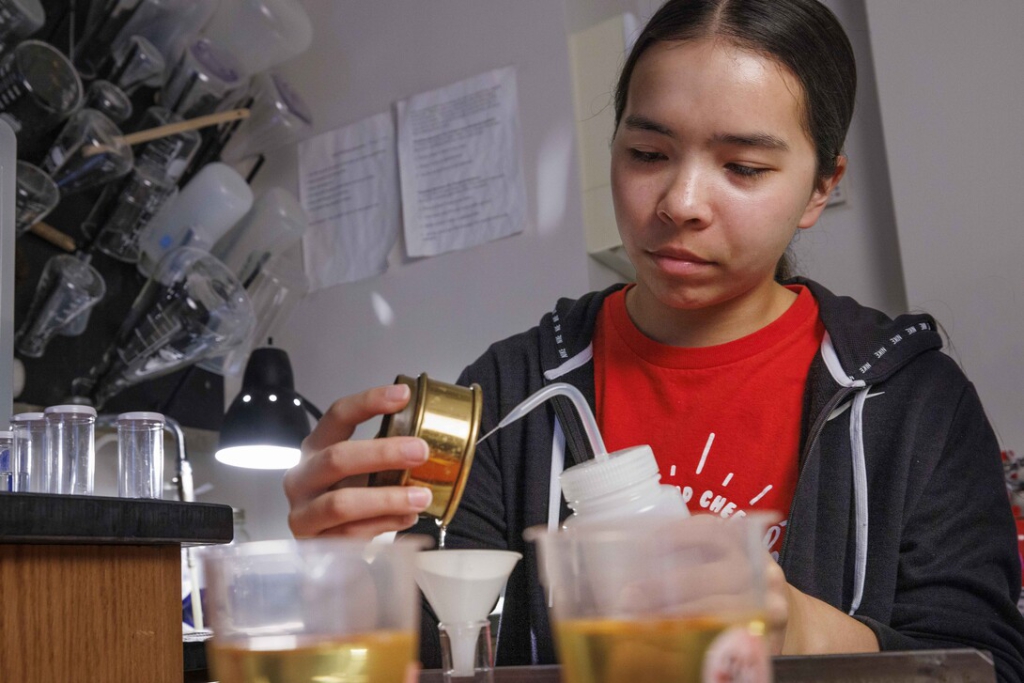Dan Moser, August 9, 2024
Onetime UCARE student Benes now mentors two students in research
In the same lab where he once worked as an undergraduate, Jim Benes now mentors two Husker undergraduates, giving him a unique perspective of the University of Nebraska–Lincoln’s UCARE program from both sides.
Benes, a doctoral student in geography who grew up on a farm outside of Lincoln, studies fire history of the northern Great Plains, including multiple sites in the Nebraska Sandhills. The first-generation college student’s interest in research was piqued by his participation in the Undergraduate Creative Activities and Research Experiences Program.

Now, two UCARE students — Jasmine Pham and Joe Stalder — are gaining hands-on research experience working with Benes.
Benes is an enthusiastic student and teacher. His long and winding path took him from military service to a stint as an aircraft mechanic, then to college.
“I wasn’t really planning to go to school,” he said, but after being laid off, his boss encouraged him to use the Post-9/11 GI Bill benefits.
“I fell in love with college. It was amazing,” said Benes, who earned a degree in geography at Nebraska before going to Montana State University-Bozeman, where he earned a master’s degree studying paleoecology, using lake sediment cores to reconstruct past vegetation and fire history.
After teaching there and working as an interpretive guide in Yellowstone National Park, he returned to Nebraska.
Sherilyn Fritz, George Holmes Professor of Earth and atmospheric sciences, was a huge influence, Benes said.
“I would always follow her back from her class and ask her all these questions,” said Benes, who grew up on a farm outside Lincoln.

He remembers how patient she was with him.
“I would go to her with the dumbest questions … and she never flinched. She was always polite. … I was this kinda-rough-around-the-edges type of student. I was curious, and I was eager, and she plugged into that.”
Fritz got Benes into the lab to do research and later suggested grad school — “to which I replied ‘What’s grad school?’”
As he works on the next phase of his academic career, Benes, along with his adviser Paul Hanson, has had the chance to hire two UCARE students to assist with his research.
“Here I am with them now doing the same thing I used to do as a first-generation student,” he said.
On a quiet afternoon in early July, Pham and Stalder are working in Benes’ lab, analyzing “cookies” — slices of charcoal samples taken from lakes or wetlands in the Sandhills. They measure the charcoal content in each slice, centimeter by centimeter, as they put together a history of fire in the region.
“Climate change, increasing fires and drought … we analyze the amount of organic material,” Pham said. “It tells us what the environment was like at the time.”

Stalder said researchers might be able to use this information to create fire management strategies to better mitigate fire danger in the future.
Recent events such as fires in Lancaster County and the Nebraska National Forest at Halsey demonstrate the importance of understanding fire’s impact on the environment in the past, Benes said.
Pham, of Lincoln, is a sophomore majoring in math, with a statistics and data science focus, and minoring in geography. Stalder, of Humboldt, is a senior who started in business but switched to geology. Both are big fans of UCARE.
“It’s a good program,” Pham said. “I’d really recommend it.”
Benes said he exposes all his students to the university’s research mission. Many are new to implementing the scientific method and are amazed at the work done in labs.

Science takes time and is often tedious, he tells his students. Researchers build on others’ work, learn new things and occasionally must admit when they are wrong. These are good lessons for students, even those who don’t intend to go into research, Benes said.
“This stuff is worthwhile. It’s worth asking about,” he said. “Plugging students into that is important.”





